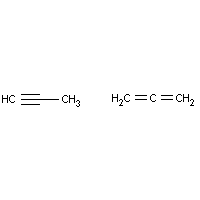Methylacetylene-propadiene mixture
Agent Name
Methylacetylene-propadiene mixture
Alternative Name
MAPP
CAS Number
59355-75-8
Major Category
Other Classes

Synonyms
MAPP gas; Methyl acetylene-allene mixture; Methyl acetylene-propadiene mixture (stabilized); Propadiene-methyl acetylene; Propyne-allene mixture; Propyne-propadiene mixture; [NIOSH] UN1060 UN1954
Category
Aliphatics, Unsaturated
Description
Colorless gas with a strong, characteristic, foul odor. [Note: A fuel that is shipped as a liquefied compressed gas.]; [NIOSH]
Sources/Uses
Used as fuel for industrial cutting; [ACGIH]
Comments
Possible frostbite from contact with liquid; [NIOSH] MAPP gas is an explosive hazard. Reduce hazard by keeping concentrations below 10% of lower explosive limit (3400 ppm). It can cause anesthetic effects and at very high concentrations, asphyxiation. At an exposure level of 5000 ppm 7 hours/day, 5 days/week, experimental animals show decreased body weight. [ACGIH] Classified as "Simple asphyxiant"; [CAMEO] Methylacetylene-propadiene mixture, stabilized (UN1060) has warning of explosive polymerization; [ERG 2016] See "Methylacetylene" and "Propadiene."
Biomedical References
Exposure Assessment
Skin Designation (ACGIH)
Insufficient data
TLV (ACGIH)
1000 ppm
STEL (ACGIH)
1250 ppm
PEL (OSHA)
1000 ppm
IDLH (NIOSH)
3400 ppm
Excerpts from Documentation for IDLHs
Basis for revised IDLH: Since a methyl acetylenepropadiene mixture appears to have relatively low toxicity, and based on an analogy to methyl acetylene [ACGIH 1991], the revised IDLH is 3,400 ppm based strictly on safety considerations (i.e., being 10% of the lower explosive limit of 3.4%).
Odor Threshold Low
100 ppm
Explosive Polymerization
Yes
Explanatory Notes
Explosion hazard; Reported odor threshold of 100 ppm; [ACGIH]
Adverse Effects
Neurotoxin
Acute solvent syndrome
Other Poison
Simple Asphyxiant
Diseases, Processes, and Activities Linked to This Agent
Diseases
Occupational diseases associated with exposure to this agent:
Processes
Industrial Processes with risk of exposure: